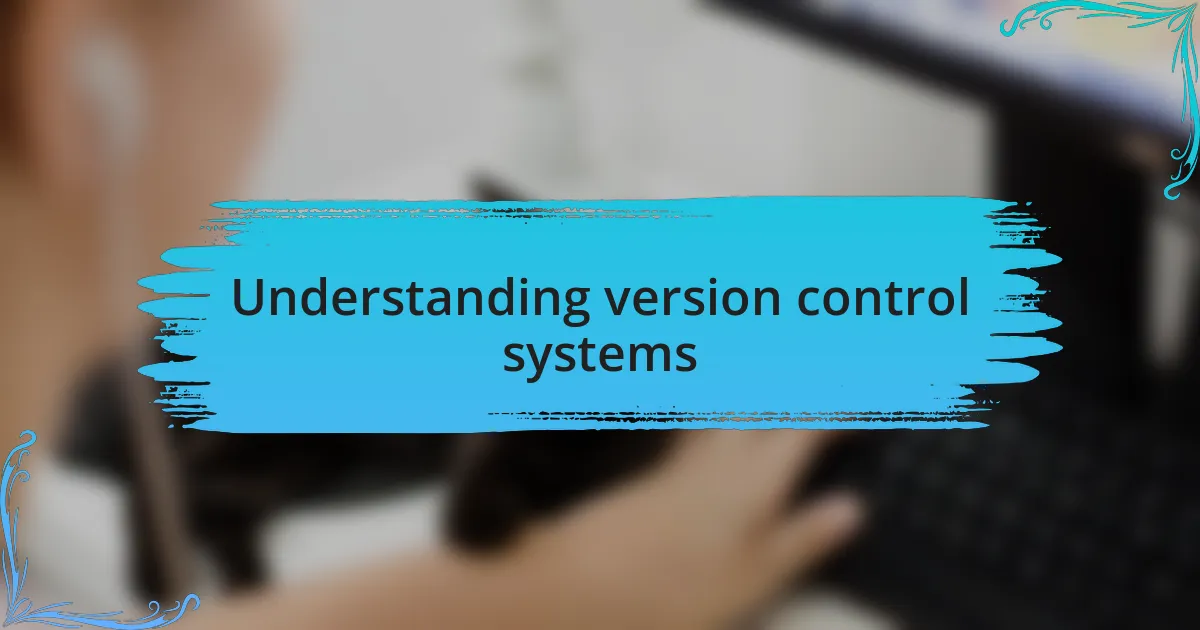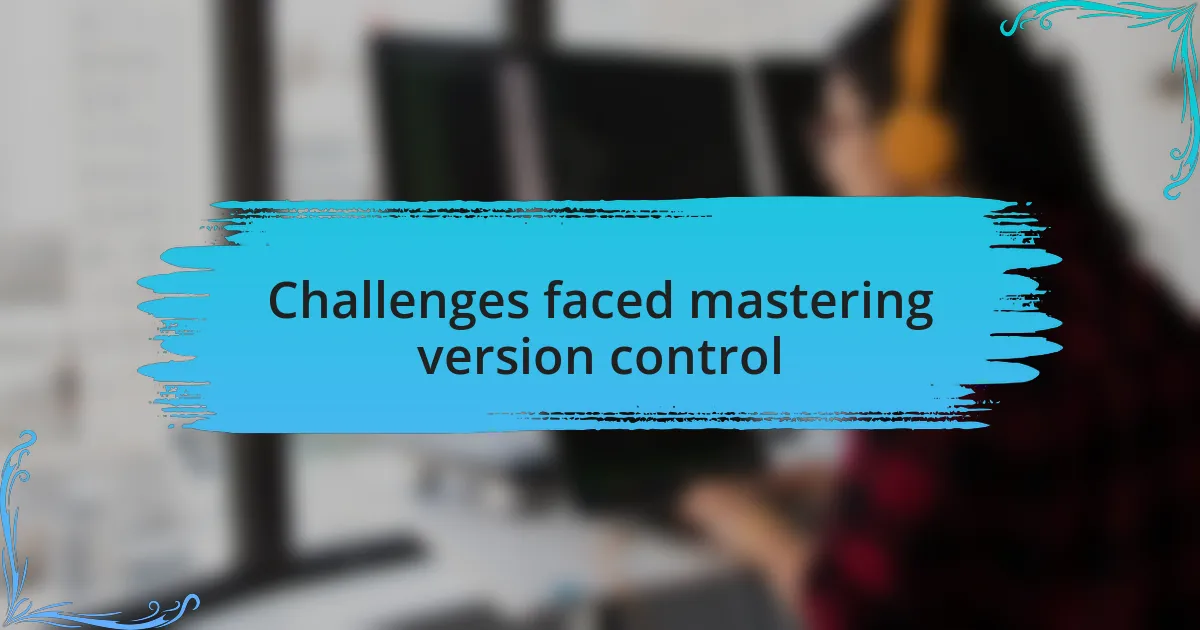Key takeaways:
- Version control systems (VCS), like Git, enable tracking changes, reverting to previous versions, and seamless collaboration among developers.
- Branching in VCS allows experimentation without affecting the main codebase, preserving project stability.
- Different VCS tools, such as Git, Mercurial, and Subversion, offer unique benefits catering to varied workflows.
- Mastering version control involves overcoming challenges like command intricacies, managing branches, and facilitating team collaboration.

Understanding version control systems
Version control systems (VCS) are like the safety net for my code. They allow me to track changes and revert to previous versions if something goes wrong. I remember a time when I accidentally deleted a crucial function late at night. Thanks to VCS, I quickly restored my work, and my panic turned into relief.
Have you ever wondered how developers collaborate seamlessly on the same project without stepping on each other’s toes? That’s one of the magic tricks of version control systems. They manage merges and conflicts, ensuring that everyone’s contributions are integrated smoothly. I’ve been part of teams where different developers worked simultaneously on various features, and, without VCS, the chaos would have been overwhelming.
Understanding the significance of branching and merging in VCS fundamentally changed the way I approach projects. Branching lets me experiment with new ideas without disrupting the main codebase. I recall creating a branch for a feature that didn’t pan out; having that flexibility not only saved time but also preserved the stability of the project. Isn’t it empowering to have that level of control over your work?

Popular version control systems overview
When discussing popular version control systems, Git is undeniably the standout choice for many developers, including myself. Its distributed nature allows multiple users to work on the same project without any hiccups. I vividly remember starting my first project with Git; the way I could branch off for experiments and then merge back seamlessly felt like having my cake and eating it too. Isn’t it reassuring to know you can try something new without the risk of breaking the entire project?
Another tool that deserves mention is Mercurial. While less popular than Git, I found its straightforward interface incredibly user-friendly. I once transitioned a legacy project to Mercurial, and that experience taught me that a tool’s simplicity can be powerful. It really made me appreciate how intuitive a version control system should be for collaboration.
Lastly, Subversion (SVN) has its loyal followers who appreciate its centralized approach. I worked on a project using SVN where the team was heavily dependent on a single repository. Although it felt less flexible than Git, I learned to value the straightforward, single-point access it provided. It’s fascinating how different systems cater to various workflows, and each has its own merits and quirks, inviting developers to choose based on what aligns with their project needs.

My journey with Git
My journey with Git has been a transformative experience, filled with both challenges and triumphs. I vividly recall the first time I encountered Git – it felt overwhelming with its myriad commands and features. But, as I spent time experimenting and building projects, I gradually unearthed its power. The learning curve was steep, but each new command I mastered brought a rush of excitement.
One of my fondest memories intertwined with Git was during a collaborative project. I remember the thrill of working with a team across different locations, knowing we could seamlessly share changes. There was an electrifying moment when I needed to resolve a merge conflict—a confusing yet enlightening puzzle to solve. After navigating those twists, I gained a deep appreciation for the collaborative potential Git offers and truly understood how it transformed workflows.
Over time, Git became my steadfast companion in development. I found comfort in utilizing features like branching and pull requests, which allowed me to experiment freely without compromising the main code. It’s remarkable how Git fosters not just individual growth, but also encourages team synergy. Have you ever felt the satisfaction of delivering a project on time, knowing that Git played a crucial role in keeping everything organized? I certainly have, and it continues to inspire my coding journey every day.

Challenges faced mastering version control
Mastering version control presented several challenges that tested my resolve as a developer. I distinctly remember grappling with the intricacies of Git commands during late-night coding sessions. Can you relate to that rush of frustration when you mistakenly overwrite files? It’s a sinking feeling that makes you realize just how essential it is to understand the consequences of each command you execute.
Another hurdle for me was figuring out the overall structure of branches and merges. I often found myself lost in a web of branches, unsure of which one to push or merge. That moment of hesitation is common, isn’t it? I learned to visualize the branching process, breaking it down into simpler components, which helped me gain clarity. Yet, the challenge of keeping my workflow organized and avoiding conflicts was something I had to continually navigate.
Lastly, mastering the art of collaboration amidst version control was no easy feat. I can recall an intense team meeting where we needed to address multiple merge conflicts simultaneously. It was stressful, but it taught me valuable lessons about communication and transparency within teams. As I engaged in discussions to untangle conflicting changes, I realized that version control isn’t just about the code—it’s about building trust and understanding amongst team members. Isn’t it fascinating how these challenges can lead us to such profound insights?